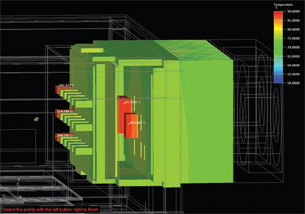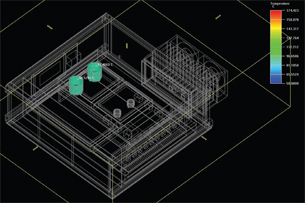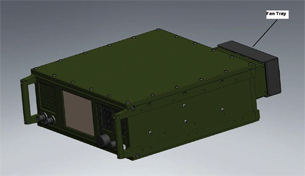Icepak Saves Radio Manufacturer Big Time and Money, 1 in a Series
ANSYS thermal simulation is credited with helping put Datron ahead by millions by getting a new military radio to market faster.
Latest News
February 1, 2009
By Patrick Weber
Page 1 | 2 »
 Figure 1: Datron’s original design of a new military radio using ferrite cores shows hot spots. |
The communications systems designed and built by Datron World Communications, Inc. of Vista,CA, present major thermal design challenges. These systems must dissipate substantial amounts of heat while remaining sealed to the outside environment to prevent damage to internal components and electromagnetic interference.
In the past, for each new product under development, Datron typically had to build and test five to 10 thermal prototypes in order to resolve thermal issues. More recently, Datron engineers began using thermal simulation software to identify and solve thermal management problems from the very early stages of the design process. Thermal problems are much less expensive to fix and can be resolved in much less time early in design when there is little or no revision required in detailed design work to accommodate any changes.
In current design efforts, Datron uses thermal simulation to resolve thermal issues with software prototypes. Because the problems are identified and fixed in the early stages, only one physical prototype is required for verification purposes. Simulation potentially saves hundreds of thousands of dollars in engineering and prototype construction costs and it gains millions of dollars in additional revenues by getting the product to market fast.
Datron’s communication systems travel with today’s soldiers and peacekeepers around the world in helicopters, ground vehicles, and on foot. The devices are designed to survive in a wide range of environments ranging from desert sandstorms to mountain blizzards. These communications systems are completely sealed, so that if one falls into a creek, for example, the user can simply pull it out and turn it on.
 Figure 2: New design with airfoil filters show temperatures are reduced to acceptable levels. (Thefilter temperatures have been reduced from the 200s into the 90s.) |
Thermal Management Challenges
Mechanical engineers involved in designing a recent radio faced the challenge of providing cooling management within a completely sealed radio cabinet in up to 50 degree C ambient temperatures. Communication systems are designed with heat sinks external to the cabinet that use forced-air conventional cooling. Components with the highest levels of power dissipation were mounted internally near those fins. Radios contain multiple printed circuit boards (PCBs) that generate substantial amounts of heat, including the power supply, RF filter, CPU, and audio components. In addition to keeping junction temperatures of board components within specifications, Datron engineers are required to limit — for safety reasons — external temperature of the heat sink to 15 degrees C above ambient temperatures.
Historically, thermal management design was based on engineering experience and instinct. This invariably resulted in an initial prototype that was unacceptable from a thermal standpoint. Mechanical engineers trying to fix the problem were hampered by the limited amount of information generated by physical testing. Without a clear understanding of what was causing the problem, engineers had to test a wide range of prospective solutions, typically leading to a plethora of prototypes. The cost of developing, building, and testing prototypes was high. But the resulting delays in bringing each new product to market were even more costly.
Evaluating ThermalSimulation Solutions
Datron engineers have improved the thermal design process by using thermal simulation. Computational fluid dynamics (CFD) provides a powerful modeling tool in which a 3D model of the system is built and the full conjugate heat transfer solution is calculated. This approach is highly accurate because it takes the full geometry of the system into account and relies on fewer assumptions, compared to other methods. CFD resolves the system flow field to a high level of detail, helping engineers identify recirculation and low flow regions. Numerical and graphical results provide an intuitive understanding of system characteristics.
One of the biggest challenges faced by Datron engineers is simulating natural convection. From a computational standpoint, natural convection is inherently difficult and expensive because the buoyancy forces are constantly changing. To aid in comparing competing thermal simulation solutions, the Datron team developed a typical natural convection problem and evaluated the ability of all the leading thermal simulation tools to solve it. Several of the software packages took 24 hours or more while ANSYS Icepak software solved the problem in only 20 minutes.
 Figure 3: CA D model showing fan tray prior to prototype. |
Datron engineers also like the nonconformal meshing tools in ANSYS Icepak, which make it possible to separately mesh — usually with a finer mesh than the rest of the model — critical areas within the system, such as high dissipation components. This increases the accuracy in the critical areas without unnecessarily increasing computational time requirements. ANSYS Icepak technology provides features that are not available in other analysis packages, including accurate modeling of non-rectangular devices, direct representation of CAD geometries, detailed trace and via modeling of printed circuit boards and package substrates, correlation-based lumped-parameter heat sink devices, and external heat exchangers.
Page 1 | 2 »
Subscribe to our FREE magazine, FREE email newsletters or both!
Latest News
About the Author
DE’s editors contribute news and new product announcements to Digital Engineering.
Press releases may be sent to them via [email protected].






